|
Song Festival Grounds, Tallinn, Estonia, July 4, 2009 (photo by Ants Liigus of Pärnu Postimees)
|
A group from Cincinnati got a taste of that in July when they attended the National Song Celebration in Tallinn, Estonia.
“If we had sent them on the Crusades, they would have taken back the Holy Land,” said Indian Hill resident John Palmer as he left the opening concert July 4 in the huge Song Festival amphitheater at the edge of the Baltic Sea in Tallinn.
Palmer’s comment was on target. Estonia, population 1.3 million, broke free of Soviet Union occupation in 1991 after a bloodless, “Singing Revolution,” waged through public demonstrations of song (see the 2006 film “The Singing Revolution” for more on this inspiring topic). Held every five years, the National Song Celebration (laulupidu) has been the focus of Estonia’s national identity for 140 years.
|
Cincinnati visitors with Paavo Järvi L to R: Nick Tsimaras, Peter Courlas, Melody Sawyer Richardson, Järvi, Vicky Motch, David Motch, Farah Palmer, John Palmer, Jody Veith (ME Hutton)
|
|
Dancers at Kalev Stadium in Tallinn, July 3, 2009 (ME Hutton)
|
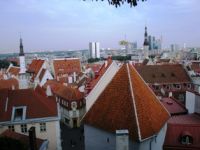
view of Tallinn's Old City from overlook at Toompea (ME Hutton)
|
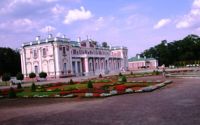
Palace of Russian Czar Peter the Great, Tallinn, Estonia (ME Hutton)
|
|
lunch at Old Hansa, Old Town, Tallinn (bottom right, David Motch, Joan Rieveschl) (ME Hutton)
|
At sunset July 2 -- near 11 p.m. mid-summer – the travelers witnessed the arrival of the Flame after its three-week journey from Tartu. On July 4, they watched the bearer of the Flame lead a procession to the Song Festival grounds for the first concert.
|
Choir from the USA in Song Celebration parade July 4, 2009 (ME Hutton)
|
|
Chorus members filling the Song Festival amphitheater (ME Hutton)
|
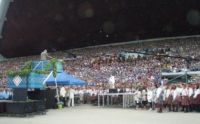
Massed choirs performing July 4, 2009, Ants Soots conductor (ME Hutton)
|
“It wasn’t just the incredible number of musicians, it was the incredible beauty of their voices that we will remember,” said travel consultant Vicky Motch, who arranged the tour.
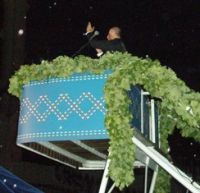
Paavo Järvi conducting in the rain (ME Hutton)
|
“The fact that our group was sitting in the cold in pouring rain and never even thought of leaving attests to how incredible the event was,” said Veith.
Choirs of all levels, including toddlers, performed traditional and popular Estonian music July 5, with the massed choir returning for “Tuljak“ (their "Hava Nagila," said Richardson) and a concluding patriotic set that produced a sea of Estonian blue-black-and-white flags.
In all, 864 choirs led by 57 conductors took part in the two concerts (about eight hours of singing).
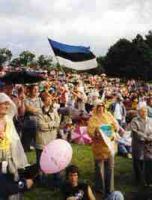
Striking the Estonian colors at the Song Festival Grounds (ME Hutton)
|
Their expressions of nationalism conveyed no sense of feeling "better than anyone," stressed Courlas. "What I saw was, 'We have pride in ourselves, and we need to express that though our music.'"
"The trip exceeded all expectations," said Rieveschl, who organized Cincinnati’s Saengerfest Bicentennial Celebration in 1988. "Boy, did you miss it," she enthuses, "but, of course, you can go in another five years (2014)."
Järvi told Agence France-Presse: "The Estonian song festival tradition is unique in the world, something that makes us feel a proud and great nation through our cultural heritage despite having a tiny population."
With 37,000 singers, dancers and musicians and 153,900 tickets sold, turnout for the 2009 Song and Dance Celebrations equaled 14.6 percent of the population, the highest figure since the end of the "Singing Revolution" (1991). Per capita, that would be nearly 318,000 in Greater Cincinnati and 42.6 million in the U.S. as a whole.
(first published in Express Cincinnati, September 2009)